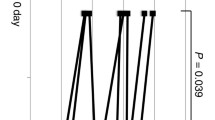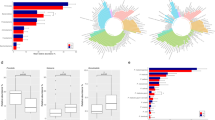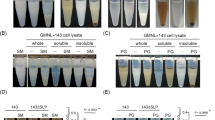Abstract
Few studies have been conducted to evaluate the effect of xylitol on the virulence and morphology of Streptococcus mutans (S. mutans). This study was conducted to evaluate changes in the morphology and virulence of S. mutans in response to long-term consumption of gum containing xylitol. Participants were voluntarily recruited for a women’s oral health prevention program, classified into two groups (a control and a xylitol group), and then followed for 1 year. Ten salivary samples were randomly selected from each group. Colony count, field emission scanning electron microscopy, and real-time reverse transcription polymerase chain reaction were used to analyze the characteristics of S. mutans. In the xylitol group, the colony counts of S. mutans decreased steadily over time. In addition, the adherence of the colonies in the xylitol group became weak, and the size of the colonies decreased compared to the control. The secretion of sticky substances from the surface of S. mutans colonies and gtfB gene expression also decreased in the xylitol group. These findings indicate that regular chewing of xylitol gum over a long period may lead to decreased gtfB expression, which can negatively affect the synthesis of extracellular polysaccharides by S. mutans, which could reduce the size and growth of S. mutans colonies and change their morphology as a result.




Similar content being viewed by others
References
Ahn SJ, Ahn SJ, Wen ZT, Brady LJ, Burne RA (2008) Characteristics of biofilm formation by Streptococcus mutans in the presence of saliva. Infect Immun 76:4259–4268
Birkhed D (1994) Cariologic aspects of xylitol and its use in chewing gum: a review. Acta Odontol Scand 52:116–127
Dills WL Jr (1989) Sugar alcohols as bulk sweeteners. Annu Rev Nutr 9:161–186
Edgar WM (1998) Sugar substitutes, chewing gum and dental caries—a review. Br Dent J 184:29–32
Hamada S, Slade HD (1980) Biology, immunology, and cariogenicity of Streptococcus mutans. Microbiol Rev 44:331–384
Hardie JM, Bowden GH (1975) Bacterial flora of dental plaque. Br Med Bull 31:131–136
Hicks J, Garcia-Godoy F, Flaitz C (2004) Biological factors in dental caries: role of remineralization and fluoride in the dynamic process of demineralization and remineralization (part 3). J Clin Pediatr Dent 28:203–214
Hildebrandt GH, Sparks BS (2000) Maintaining mutans Streptococci suppression with xylitol chewing gum. J Am Dent Assoc 131:909–916
Isokangas P, Söderling E, Pienihäkkinen K, Alanen P (2000) Occurrence of dental decay in children after maternal consumption of xylitol chewing gum, a follow-up from 0 to 5 years of age. J Dent Res 79:1885–1889
Koga T, Asakawa H, Okahashi N, Hamada S (1986) Sucrose-dependent cell adherence and cariogenicity of serotype c Streptococcus mutans. J Gen Microbiol 132:2873–2883
Ly KA, Milgrom P, Rothen M (2006) Xylitol, sweeteners, and dental caries. Pediatr Dent 28:154–163
Lynch H, Milgrom P (2003) Xylitol and dental caries: an overview for clinicians. J Calif Dent Assoc 31:205–209
Mäkinen KK, Söderling E, Isokangas P, Tenovuo J, Tiekso J (1989) Oral biochemical status and depression of Streptococcus mutans in children during 24- to 36-month use of xylitol chewing gum. Caries Res 23:261–267
Mäkinen KK, Bennett CA, Hujoel PP, Isokangas PJ, Isotupa KP, Pape HR Jr, Mäkinen PL (1995) Xylitol chewing gums and caries rates: a 40-month cohort study. J Dent Res 74:1904–1913
Mäkinen KK, Isotupa KP, Mäkinen PL, Söderling E, Song KB, Nam SH, Jeong SH (2005) Six-month polyol chewing-gum programme in kindergarten-age children: a feasibility study focusing on mutans Streptococci and dental plaque. Int Dent J 55:81–88
Mäkinen KK, Saag M, Isotupa KP, Olak J, Nõmmela R, Söderling E, Mäkinen PL (2005) Similarity of the effects of erythritol and xylitol on some risk factors of dental caries. Caries Res 39:207–215
Matsukubo T, Takazoe I (2006) Sucrose substitutes and their role in caries prevention. Int Dent J 56:119–130
Miake Y, Saeki Y, Takahashi M, Yanagisawa T (2003) Remineralization effects of xylitol on demineralized enamel. J Electron Microsc 52:471–476
Mitchell TJ (2003) The pathogenesis of streptococcal infections: from tooth decay to meningitis. Nat Rev Microbiol 1:219–230
Modesto A, Drake DR (2006) Multiple exposures to chlorhexidine and xylitol: adhesion and biofilm formation by Streptococcus mutans. Curr Microbiol 52:418–423
Motegi M, Takagi Y, Yonezawa H, Hanada N, Terajima J, Watanabe H, Senpuku H (2006) Assessment of genes associated with Streptococcus mutans biofilm morphology. Appl Environ Microbiol 72:6277–6287
Napimoga MH, Kamiya RU, Rosa RT, Rosa EA, Höfling JF, Mattos-Graner RO, Gonçalves RB (2004) Genotypic diversity and virulence traits of Streptococcus mutans in caries-free and caries-active individuals. J Med Microbiol 53:697–703
Shemesh M, Tam A, Steinberg D (2007) Differential gene expression profiling of Streptococcus mutans cultured under biofilm and planktonic conditions. Microbiology 153:1307–1317
Söderling E, Pihlanto-Leppälä A (1989) Uptake and expulsion of 14C-xylitol by xylitol-cultured Streptococcus mutans ATCC 25175 in vitro. Scand J Dent Res 97:511–519
Söderling E, Scheinin A (1991) Perspectives on xylitol-induced oral effects. Proc Finn Dent Soc 87:217–229
Söderling E, Mäkinen KK, Chen CY, Pape HR Jr, Loesche W, Mäkinen PL (1989) Effect of sorbitol, xylitol, and xylitol/sorbitol chewing gums on dental plaque. Caries Res 23:378–384
Söderling E, Trahan L, Tammiala-Salonen T, Häkkinen L (1997) Effects of xylitol, xylitol-sorbitol, and placebo chewing gums on the plaque of habitual xylitol consumers. Eur J Oral Sci 105:170–177
Söderling E, Isokangas P, Pienihäkkinen K, Tenovuo J (2000) Influence of maternal xylitol consumption on acquisition of mutans Streptococci by infants. J Dent Res 79:882–887
Söderling E, Isokangas P, Pienihäkkinen K, Tenovuo J, Alanen P (2001) Influence of maternal xylitol consumption on mother-child transmission of mutans Streptococci: 6-year follow-up. Caries Res 35:173–177
Steinberg LM, Odusola F, Mandel ID (1992) Remineralizing potential, antiplaque and antigingivitis effects of xylitol and sorbitol sweetened chewing gum. Clin Prev Dent 14:31–34
Tanzser JM (1995) Xylitol chewing gum and dental caries. Int Dent J 45:65–76
Thorild I, Lindau B, Twetman S (2004) Salivary mutans Streptococci and dental caries in three-year-old children after maternal exposure to chewing gums containing combinations of xylitol, sorbitol, chlorhexidine, and fluoride. Acta Odontol Scand 62:245–250
Toda Y, Moro I, Koga T, Asakawa H, Hamada S (1987) Ultrastructure of extracellular polysaccharides produced by serotype c Streptococcus mutans. J Dent Res 66:1364–1369
Trahan L (1995) Xylitol: a review of its action on mutans Streptococci and dental plaque-its clinical significance. Int Dent J 45:77–92
Trahan L, Bareil M, Gauthier L, Vadeboncoeur C (1985) Transport and phosphorylation of xylitol by a fructose phosphotransferase system in Streptococcus mutans. Caries Res 19:53–63
Tuompo H, Meurman JH, Lounatmaa K, Linkola J (1983) Effect of xylitol and other carbon sources on the cell wall of Streptococcus mutans. Scand J Dent Res 91:17–25
Wennerholm K, Arends J, Birkhed D, Ruben J, Emilson CG, Dijkman AG (1994) Effect of xylitol and sorbitol in chewing-gums on mutans Streptococci, plaque pH and mineral loss of enamel. Caries Res 28:48–54
Acknowledgment
This study was supported by the Kyungpook National University Research Fund, 2007.
Author information
Authors and Affiliations
Corresponding author
Rights and permissions
About this article
Cite this article
Lee, YE., Choi, YH., Jeong, SH. et al. Morphological Changes in Streptococcus mutans After Chewing Gum Containing Xylitol for Twelve Months. Curr Microbiol 58, 332–337 (2009). https://doi.org/10.1007/s00284-008-9332-4
Received:
Revised:
Accepted:
Published:
Issue Date:
DOI: https://doi.org/10.1007/s00284-008-9332-4




